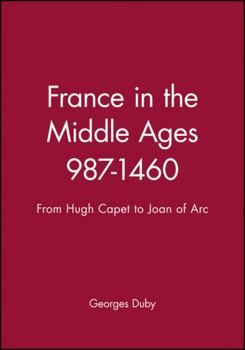France in the Middle Ages 987-1460: From Hugh Capet to Joan of Arc
(Book #1 in the History of France Series)
Select Format
Select Condition 
Book Overview
In this book, now available in paperback, he examines the history of France from the rise of the Capetians in the mid-tenth century to the execution of Joan of Arc in the mid-fifteenth. He takes the... This description may be from another edition of this product.
Format:Paperback
Language:English
ISBN:0631189459
ISBN13:9780631189459
Release Date:December 1993
Publisher:Wiley-Blackwell
Length:384 Pages
Weight:1.50 lbs.
Dimensions:1.1" x 6.7" x 9.7"
Related Subjects
Education & Reference Europe Foreign Language Study & Reference France History ReferenceCustomer Reviews
2 ratings
Excellent Insights from an Important French Historian
Published by Thriftbooks.com User , 16 years ago
This volume by Georges Duby (1919-1996), distinguished professor emeritus of the Collège de France, was written about ten years before his death. It is an excellent resource and a good introduction to French medieval history for the serious student of French history. His argument is especially strong in connecting the evolving French political, economic, and intellectual movements to counter-developments in historic events and thought. It is part of a larger series on French history that was commissioned to celebrate the Millennium, and his section, despite its title, is a short introduction that introduces his real expertise in the eleventh through thirteenth centuries, with a short wrap-up of the fourteenth and fifteenth centuries. The choice of Joan of Arc to represent the fifteenth century is meant to connect to the next volume (written by Leroy Ladurie) and to demonstrate the continuing romantic influence of the symbolism of the Middle Ages--especially through adaptation of sacred symbols to modern and secular movements and national allegiance. Duby's historical narrative voice is lively, engaging, intelligent, humble, and authoritative. I like his voice, so I enjoyed the book. Overall, the book is one which would stimulate discussion and cause serious students to want to inquire further, while providing excellent insights from an important French historian.
Omnia Gallia Divisa....
Published by Thriftbooks.com User , 23 years ago
Once upon a time, France did not exist. Julius Caesar said the land of the Gauls (tribes the Greeks called Keltoi) was divided into three parts and he set out to conquer them all. Caesar was probably speaking of the area known today as France, as well as parts of Switzerland, Germany, and the Low countries. Caesar subdued many tribes in living in the land of the Gauls, but only the southern part was ever completely romanized -- Gallia Narbonensis. When the Roman Empire collapsed, Northern Gaul was once again dominated by warriors known as Franks. George Duby begins his story in the year 987 A.D. and ends it in 1460 with the success of the Capetians who in defeating Henry VI, finally drove the English from their land. During this 500 year period, France developed from a land composed of small settlements and huge swaths of rural farmland and wilderness to a network of villages and towns centered on commerce and trade. In 987 A.D. Duby says power was tied to geneology, but by the end, wealth was also a major factor.Duby not only addresses the Middle Ages of 987 to 1460 A.D., but he comments on how he as an historian went about reconstructing his story from contemporary materials available from various sources. So, this is not only a history book, it is a book on historiography of sorts. For example, Duby says the use of various Latin words in various documents could mean many different things. How does the historian know what these terms imply? The underlying meaning of Latin words changed over time, just as English words we use today have changed meaning over time.My favorite section of the book is "The Village." Around 1,000, villages as they came to be known, did not exist in France. There were 'bourgs' which were small towns outside the gates of walled monasteries, or where a castle or a Roman Villa had once existed. Castles were built everywhere during the Feudal period as lords battled for control of their lands. These castles were known in France as 'maisons fortes' or fortified houses. Lords and their retinues moved from one fortified house to another and never slept in the open. In the southwest, these fortified castles were known as 'castelnaus.' Because of the power of the church, the territory now know as France seems to have been organized into parishes (parochia). The parish center was a church (later a cathedral) and it's burial grounds. Christian churches were probably built where pagan structures had once stood. (Panofsky suggests the major Cathedrals in France are laid out in the pattern of the constellation Libra). Women came to the burial grounds and left grave goods, a pagan practice Duby says the church eventually eradicated (guess he didn't read "Midnight in the Garden of Good and Evil").Duby indicates there was little "law and order" of the sort dominant males appreciate in 1,000 A.D. He says many groups vied for power including a multitude of splinter groups who "occupied t





